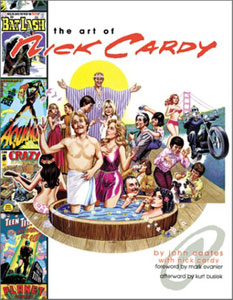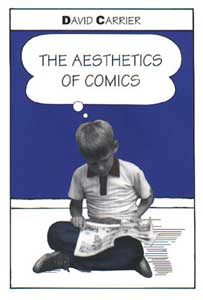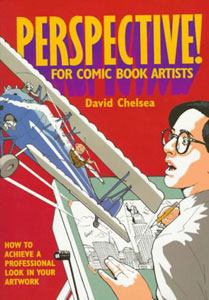|
|

|
| . |
|
|
|
|
|
|
| NICK
CARDY |

|
The
Art of
NICK
CARDY |
by John Coates with Nick Cardy
Foreword by Mark Evanier
Afterword by Kurt Busiek |
Paperback: 176 pages
Watson-Guptill Publications
ISBN: 1887591222 |
|
$19.95

|
The incredible work of comic-book
and commercial artist Nick Cardy is showcased in this handsome volume.
Cardy is best known for his 25+ year work at DC Comics, where he drew such
comics as AQUAMAN, BAT LASH, and THE TEEN TITANS. |
|
|
|
|
| DAVID
CARRIER |

|
The
AESTHETICS
of
COMICS |
| by David Carrier |
Hardcover: 152 pages
Pennsylvania State University Press
ISBN: 027101962X |
|
$29.95

|
| From Gary Larson's
The Far Side to George Herriman's Krazy Kat, comic strips have two obvious
defining features: They are visual narratives, using both words and pictures
to tell stories, and they use word balloons to represent the speech and
thought of depicted characters. Art historians have studied visual artifacts
from every culture; cultural historians have recently paid close attention
to movies. Yet the comic strip, an art form known to everyone, has not
yet been much studied by aestheticians or art historians. This is the first
full-length philosophical account of the comic strip. |
|
|
|
The publisher,
Penn State University Press:
The first full-length philosophical
study of comic strips.
Distinguished philosopher
David Carrier looks at popular American and Japanese comic strips to identify
and solve the aesthetic problems posed by comic strips and to explain the
relationship of this artistic genre to other forms of visual art. He traces
the use of speech and thought balloons to early Renaissance art and claims
that the speech balloon defines comics as neither a purely visual nor a
strictly verbal art form, but as something radically new. Comics, he claims,
are essentially a composite art that, when successful, seamlessly combine
verbal and visual elements.
.
Carrier looks at the way
an audience interprets comics and contrasts the interpretation of comics
and other mass-culture images to that of Old Master visual art. The meaning
behind the comic can be immediately grasped by the average reader, whereas
a piece of museum art can only be fully interpreted by scholars familiar
with the history and the background behind the painting.
.
Finally, Carrier relates
comics to art history. Ultimately, Carrier's analysis of comics shows why
this popular art is worthy of philosophical study and proves that a better
understanding of comics will help us better understand the history of art.
"Carrier's gracefully erudite
book will do for the comics what Stanley Cavell has done for Hollywood
movies."
George J.
Leonard,
Universal Pictures, Hollywood/Conception
and Choreography, Sha Na Na
.
"The ingenuity with which
the classical comic strip artists found ways of telling whole stories in
four or five panels has been insufficiently appreciated by philosophers
or historians of art. Carrier has written a marvelous book on these narrative
strategies, from which we cannot but learn something about how the mind
processes pictorial information and how the Old Masters coped with the
urgent stories simple people had to understand."
Arthur Danto,
Columbia University
.
"Carrier is an academic
philosopher who also works as an engaged commentator on contemporary art.
His writings tend to be full of witty rhetorical constructions, and thus
they are entertaining to read in ways that most contemporary academic writing,
whether on philosophy or art or both, is not."
Bill Berkson,
San Francisco Art Institute
.
"David Carrier has written
a most perceptive and readable account of that great American apparatus-the
comic strip. Historically accurate and philosophically bracing, this is
a truly terrific book. Carrier has done a necessary and brilliant service,
and he has provided a true gift to all who admire the comic strip tradition."
Archie Rand,
Columbia University
|
|
|
|
|
|
|
| DAVID
CHELSEA |

|
PERSPECTIVE!
For
Comic Book Artists
How to Achieve a Professional
Look in Your Artwork |
| by David Chelsea |
Paperback: 176 pages
Watson-Guptill Publications
ISBN: 0823005674 |
|
$19.95

|
| Artist David
Chelsea has put together a great guide to the principles of perspective
in drawing. Written in a comic-strip format inspired by Understanding Comics,
David presents what he calls "the first user-friendly book on Perspective." |
|
|
|
| The plot here
isn't particularly harrowing -- David's friend Mugg, who sort of looks
like a realistic Too Much Coffee Man, is having problems getting his superhero
slugfests to come out right. And no wonder -- his perspective is all wrong.
Enter David to save the day with example after example of the techniques
of constructing one-point, two-point and three point perspectives, and
short cuts to "fake" perspective. |
|
|
|
|


